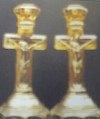Carnival Glass 101 | home Quick Reference to Carnival Glass Patterns on This Site
Cambridge - Part 8
CAMBRIDGE GLASS – Part 8
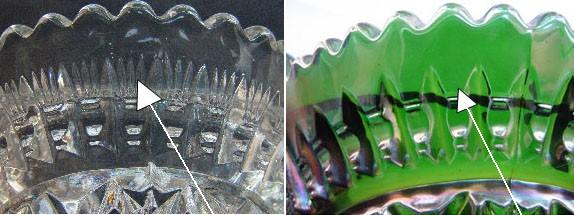
Left - Original mold, Right - Ground & polished mold.
FORKS: This will no doubt come as a surprise to many folks! We have discovered the Forks Cracker jar and cover to be listed as #410 on page 25 in the 1909 Imperial Catalog, as well as posted in Imperial Catalog 104A on page 72A, as #410, indicating that Cambridge must have purchased the mould from Imperial. There is no trademark in the bottom nor on either handle of the clear glass jar or the green example.
Evidence indicates that from time to time, glass companies make available to other producers; moulds which they have not found successful, or perhaps had on hand, but had never utilized to any large degree? Whatever the reason, we know there was a transfer of this mould. The first glass was produced by Imperial on January 13, 1904.
Fenton Glass produced the first Carnival glass in 1907. Cambridge “is said” to have produced its first Carnival glass in 1908. It was not until 1909 that John Fenton produced his first glass at Millersburg. A stated fact indicates Millersburg molds were sent to Fenton Glass for processing and iridization, prior to full operation of the Millersburg factory. While there no doubt was a working relationship among all glassmakers of that era, we do not feel that Millersburg would have done any iridizing for Cambridge, since by 1911, Millersburg's bubble had burst and thrown them into a tailspin of financial trouble. Although large quantities of Radium glass was produced in a very short time, Millersburg again fell idle forever in 1912.
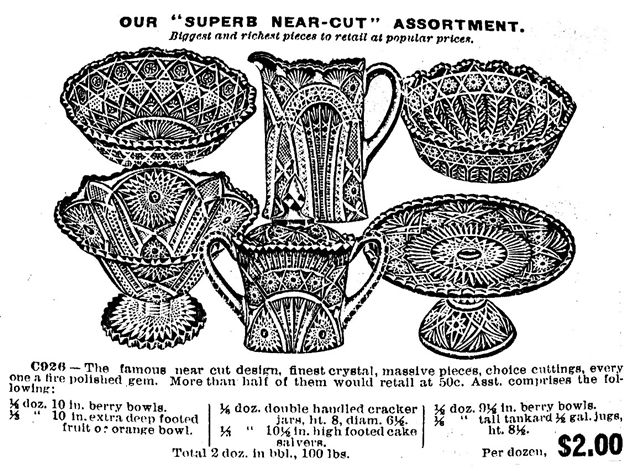
Fall 1908 Butler Bros. Catalog.
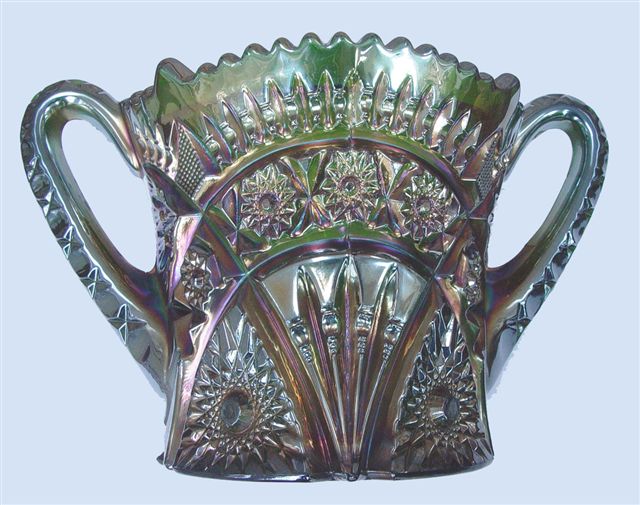
Factory # 2696 was applied to this 8 ½”green squat cracker jar when produced in crystal.
According to “Colors in Cambridge Glass”, Cambridge also produced Carnival Glass during the years 1916-1917. There are four color classifications listed: Marigold on crystal blanks; Green on emerald green blanks, Blue on Royal blue blanks; and Purple on mulberry blanks. All blank colors used were introduced in 1916. We all know of the relative scarcity today, indicating the small numbers produced.
Convinced as we are that Cambridge made no green Forks Cracker Jars, we further state that of the ten examples of Cambridge patterns that we own, only the green Inverted Thistle 3-toed Nut Bowl, along with the crystal and the green NEARCUT Decanters are trademarked: NEAR CUT.
An article which came to our attention following purchase of a “NEARCUT” Catalog at the Cambridge Museum may clear up some questions many of us have raised over the years, questioning the lack of green Wheat Sheaf and green NEARCUT Decanters, as well as there being no iridized shot glasses to accompany those decanters.
Sometimes speculation and “unfounded assumptions”, along with collectors' willingness to accept whatever “pleases” our rationale; allow passing time to cloud the truth surrounding the unknown. Until we purchased (at long last), an example of the crystal Forks at the local Christy's Auction House in Indy, July 2010, we had never been able to make a comparison study of the distinct differences between it and the green Forks. The absence of green lids has created questions over the years, but relying on Dean's experience with molds, combined with known “trickery of the trade” in glass production, we believe we have finally arrived at a satisfactory conclusion.
Orrie J. Mosser was born in Marietta, OH in 1886. His lifetime career in the glass trade began when he was twelve, (reportedly) learning the “gathering” trade at a Marietta, OH glass plant. (A branch of National Glass in Marietta burned in 1903). Fenton Glass Co. was operating full-bore in 1908, when Mosser would have been 12 yrs. of age. Seems more likely that Fenton was the source of learning to “gather” by Orrie Mosser.
Mr. Mosser worked at the Byesville, OH plant of Cambridge Glass Co. When the Byesville plant closed and was moved to Cambridge, Mr. Mosser went to the Cambridge plant as a “gatherer”. After working his way through several departments, he was made night foreman, a position he held for five years. In Aug. 1917 Mr. Mosser succeeded James Madden as plant manager of the hot metal department (the part of the factory which actually produced glass from the basic raw materials into molded or blown glassware). He continued as plant manager for the Cambridge Glass Company until retirement in April 1957.
Following his retirement, Orrie Mosser went to work for his son, Thomas Mosser at the Variety Glass Co. Their plant was near Indian Camp, a small village north of Cambridge, OH.
We believe you can understand the advantage Mr. Mosser had “at his finger tips”, surrounding Cambridge molds which were no longer in use, and his opportunity in securing such molds for creating many of the Carnival examples found in the years since? Close inspection of the Forks jar lid indicates a bare 1/16” thickness along the deep ridge lines. Lid production in the upside down position we show, means that with the two parts involved in the portion above the lid itself, stress was involved each time the mold was opened to place the three sections into one. Over time, the mold wore beyond use. The obvious grinding/smoothing seen on the jar explains the stresses involved in use.
As you can see on the green Forks cracker jar, at the top of the wheat sheaf, 3 heads have been ground off. The middle wheat sheaves with 4 heads have also been ground off. The probable cause of this action was that over time the wheat heads cracked from wear and broke out sections between the heads. There is no way to repair this damage. Cast iron can only be braised using oxygen & acetylene. Subjected to intense heat with use, the mold would be susceptible to damage and would not hold. The solution is to grind off the damaged areas; in this case, the heads of the wheat.

FORKS lid in upside down position.
Viewing the photo showing the lid: One half of the knob is one section. The second section is from the middle of the knob to the hexagon portion, and the third section is the lid portion itself. This is the likely place for the mould to have cracked or broken, rendering it useless.
We suspect that Cambridge may never have made any green glass. Possibly the molds passed to the Variety Glass/Mosser glass company, which in turn created the few examples known today? So few examples in each of 30 different patterns are found in green; a lack of any complete table sets, etc., that perhaps a single pot of green glass could have provided means to supply all of the green examples in various patterns known today. A day pot requires less than 800 lbs. of silica sand. This would have provided the green selections we see today. If Cambridge had made green glass at the 1200 lb. requirement to create a full pot of glass, the results would have produced at least 900 pcs. of glass. There simply are not that many pieces known to exist!
The same skepticism extends to the very few items found in blue within the Inv. Strawberry design, especially since there is verification that water tumblers “and other pieces” are known to have been made from new molds! A creamer and sugar, spooner, 5 ½” footed jelly and the 4” nappy have been found in blue.
Tumblers in the Inverted Strawberry pattern were heavily reproduced in many colors in Carnival by Hansen, Bennett, Westmoreland, Crider and Guernsey. Said to have been signed by these various makers, we all know that in some cases, those marks have been ground/smoothed out. About 30 blue pitchers were iridized in 1972 by Guernsey and an additional 100 in purple in 1977. These pitchers are smaller and shaped much differently than the old tankard, which makes them easy to spot. *In 1977, Mosser Glass Inc., reproduced the tumbler and the covered butter in ice blue.
The Nearcut green decanter is more squatty and bulbous at the base of the container and not as tall as its crystal counterpart.
Our previous segment: Cambridge Glass-Part 7 shows the catalog drawing of the basic vase, having scalloped top edge. We feel that since no Inverted Feather tankards are shown in the Cambridge crystal production catalog: that vase mold was later altered by extending the top upwards so that it could be pulled down to form the spout. A new retaining ring with no scallops-perfectly round, had to be used. Stuck handles; the two known tankards resulted………..one marigold and one purple. There is also a known ruffled vase in pale marigold.
Whether or not you agree with our foundational assessment in this article, it should offer new ground for serious speculation!
Many of us have lived long enough to believe that all which has been written over time is no longer entirely believable.
We are discovering that many previously written statements are based on mere speculative assumption.
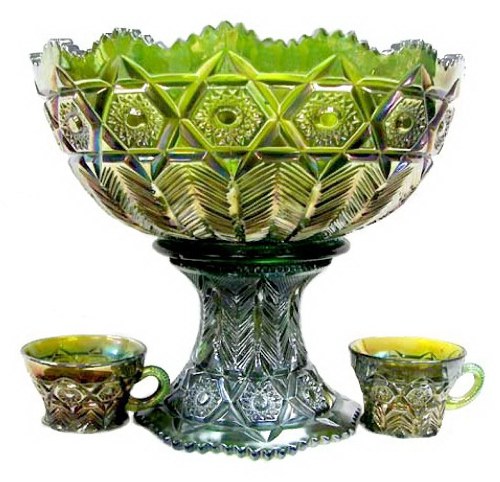
INVERTED FEATHER Set in Museum has flared bowl.
Courtesy Wroda Auctions.
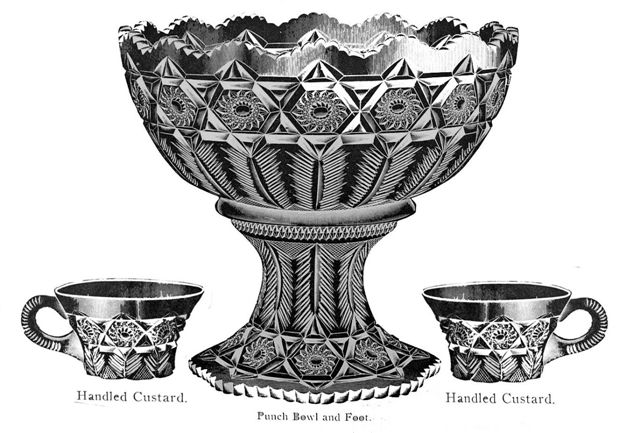
Inverted Feather ad from Cambridge Glass Factory Catalog.- Near-Cut line.
INVERTED FEATHER Punch Set: This is the second known punch set in the pattern. Both are green and the one on display in the Cambridge Museum has a more flared bowl than this example. The one pictured here was sold by Wroda Auctions in late January 2009. If you click here, you may view the set seen in the Museum.
Factory #2651 applies to crystal examples in this pattern. Punch bowl & Foot, along with handled custard cups are known in marigold and green.
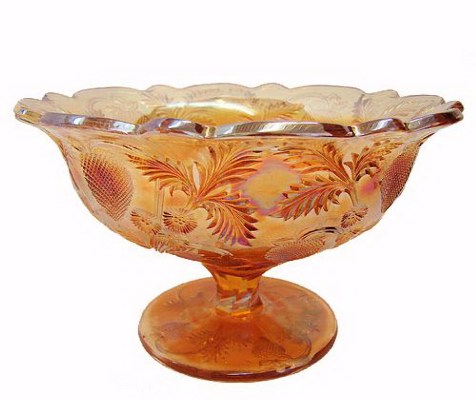
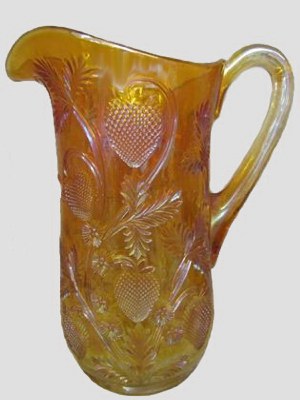
9.5 in. INVERTED STRAWBERRY Compote and Tankard - Marigold.
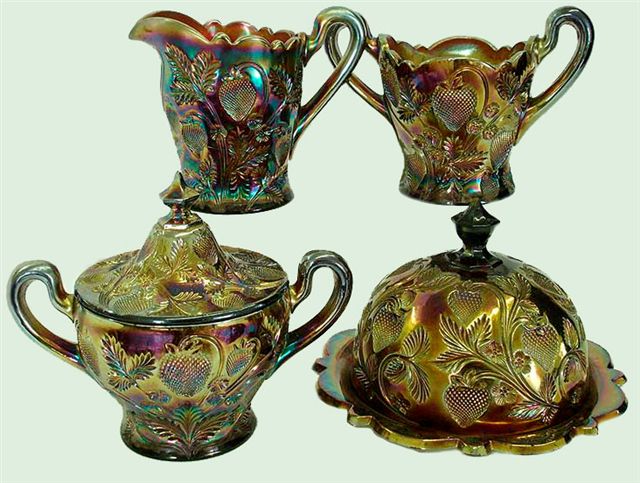
Purple INV. STRAWBERRY - Courtesy Seeck Auctions. - 7-10 - sold for $375.
INVERTED STRAWBERRY Compote: This 9 ½” low ftd. bowl or compote is known in marigold and purple.
INVERTED STRAWBERRY Table Set: Covered sugar is known in marigold, green, purple. – Spooner, marigold, green, purple, blue. – Creamer, marigold, green, purple, blue. – Butter, marigold, purple.
INVERTED STRAWBERRY Tankard: ½ gallon size Tankard was made in marigold, green and purple. The 1 qt. size Tankard was made in purple only. Tankards, tumblers and other pieces have been made from new molds in this pattern. This listing is for old glass only.
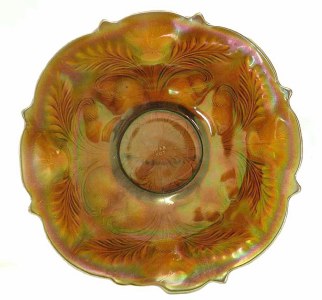
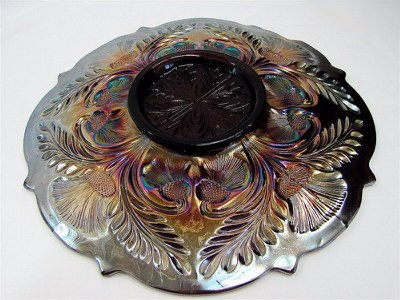
Left - Green INVERTED THISTLE Chop Plate - only one known.
Right - 11 in.INVERTED THISTLE- Purple Plate - Seeck Auction - 7-10 - sold for $1400.
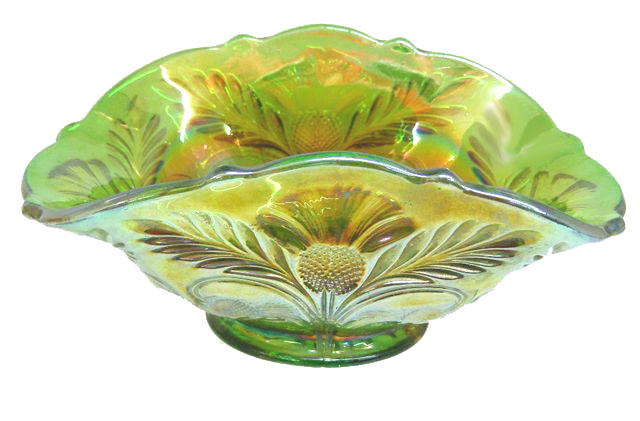
7.25 in. INVERTED THISTLE Banana Bowl.
INVERTED THISTLE Chop Plate: Dr. Jack and Mary Adams were closely associated with the National Cambridge Collectors. Inc. At the time of Mary’s documentary writing in June 1985, regarding patterns found in carnival glass, she notes one 11” purple plate known in that pattern.
INVERTED THISTLE Banana Boat: This is an unusual shape and one which many of us “old-timers” have not seen before.
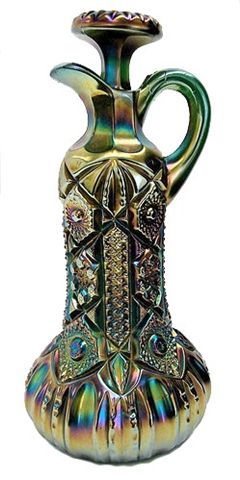
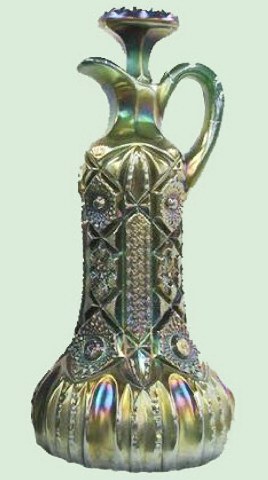
Left - Green NEARCUT Decanter - Phillips Auction. - Sold for $2200. - 7-10.
Right - Green NEARCUT - Funk Auction - 5-8-10 - sold for $2600.
NEARCUT Decanter: Two green examples known-with Cambridge Factory # 2666 applied to their crystal decanters. We first saw this piece sitting on the top shelf of a huge carnival glass display while visiting the late Marge and Ed Garner in northern California in the Fall of 1982 while attending a meeting of that Club. When their collection sold in May 1983, the late Woody and Marlene Funk of PA purchased the decanter for $3500. It sold in May 2010 for $2600.
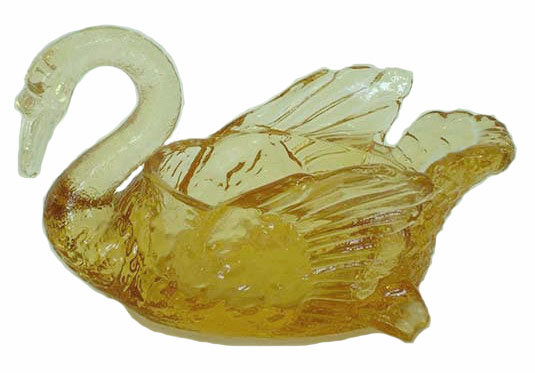
Cambridge SWAN Salt.
SWAN: Cambridge made a rather elongated Swan design as compared to the swan salts produced by other manufacturers. They seem to be few in number and seen in marigold.
Measurements: 2” tall x 3 5/8” long x 2” wide.
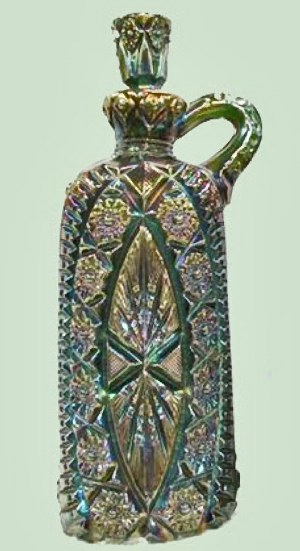
WHEAT SHEAF Decanter - sold for $2600
Funk Auction - 5-8-10.
WHEAT SHEAF Decanter: There is only one example known in this 32oz. green whiskey decanter. The Cambridge factory gave it the #2660 for crystal examples. (NOTE: The Cambridge “NEARCUT” Catalog calls this Whiskey Jug and Tumbler).
Dean & Diane Fry – 02/11
The Evil That Men Do is a quotation from Act 3, scene 1 of Julius Caesar by William Shakespeare
(Mark Antony: “The evil that men do lives long after them; but the good is oft interred with their bones.
So let it be with noble Caesar; he who hath told you so!”)
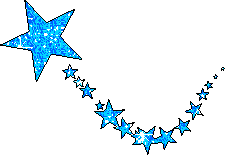

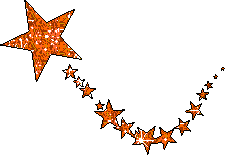

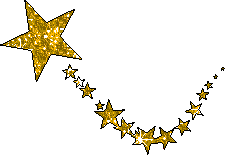


But you, beloved, building yourselves up on your most holy faith,
Praying in the Holy Spirit, keep yourselves in the love of God,
Looking for the mercy of our Lord Jesus Christ unto eternal life.
And on some have compassion, making a distinction; but others save with fear,
pulling them out of the fire, hating even the garment defiled by the flesh.
Now to Him who is able to keep you from stumbling,
and to present you faultless before the presence of His glory with exceeding joy,
to God our Savior, who alone is wise, be glory and majesty,
dominion and power, both now and forever. Amen. (Jude 1:20-25)












Should you care to contact the Frys, their email address is:
Search Carnival Glass 101
back to Carnival Glass 101
Our other sites you may enjoy:
Everything you EVER wanted to know about Indiana Glass
Great Reference for Newer Carnival Glass.
Complete Glassware Catalogs Available to Download
Questions? Comments? Suggestions? Broken Links? Corrections?
Your Friendly Webmaster is here to help!
